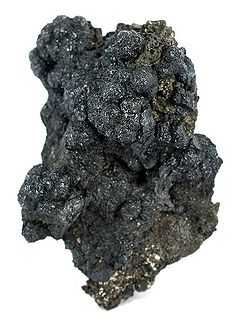Argyrodite
| Argyrodite | |
|---|---|
|
Argyrodite from the type location in Germany (size: 4.9 x 3.2 x 2.3 cm) | |
| General | |
| Category | Sulfide mineral |
| Formula (repeating unit) | Ag8GeS6 |
| Strunz classification | 02.BA.35 |
| Crystal symmetry | Orthorhombic mm2 pyramidal |
| Unit cell | a = 15.149 Å, b = 7.476 Å, c = 10.589 Å; Z = 4 |
| Identification | |
| Color | Black, purplish tinge |
| Crystal habit | Pseudo-octahedra, dodecahedra, cubes; radiating crystal aggregates, botryoidal crusts, or massive |
| Crystal system | Orthorhombic - pseudo-cubic |
| Twinning | Pseudospinel law {111} penetration twins |
| Cleavage | Absent |
| Fracture | Uneven to conchoidal |
| Mohs scale hardness | 2.5 |
| Luster | Metallic |
| Diaphaneity | Opaque |
| Specific gravity | 6.2-6.5 |
| Optical properties | Weakly anisotropic |
| Pleochroism | Weak |
| References | [1][2] |
Argyrodite is an uncommon silver germanium sulfide mineral with formula Ag8GeS6. The color is iron-black with a purplish tinge, and the lustre metallic.
Discovered by Clemens Winkler in 1886,[3] it is of interest as it was described shortly after the element germanium was isolated, 15 years after it had been postulated by Mendeleev. It was first described for an occurrence in the Himmelsfürst Mine, Erzgebirge, Freiberg, Saxony, Germany.[2]
The Freiberg mineral had previously been imperfectly described by August Breithaupt under the name plusinglanz, and Bolivian crystals were incorrectly described in 1849 as crystallized brongniardite.[3]
Isomorphous with argyrodite is the corresponding tin bearing mineral Ag8SnS6, also found in Bolivia as pseudocubic crystals, and known by the name canfieldite.[3] There is also a related mineral, putzite, with composition (Cu4.7Ag3.3)GeS6.
Argyrodite gets its name from the Greek words that loosely translate into "rich in silver".[1]
References
- ↑ 1.0 1.1 Handbook of Mineralogy
- ↑ 2.0 2.1 Mindat.org
- ↑ 3.0 3.1 3.2 Spencer 1911, p. 488.
- Attribution
 This article incorporates text from a publication now in the public domain: Spencer, Leonard James (1911). "Argyrodite". In Chisholm, Hugh. Encyclopædia Britannica 2 (11th ed.). Cambridge University Press. p. 488.
This article incorporates text from a publication now in the public domain: Spencer, Leonard James (1911). "Argyrodite". In Chisholm, Hugh. Encyclopædia Britannica 2 (11th ed.). Cambridge University Press. p. 488.
